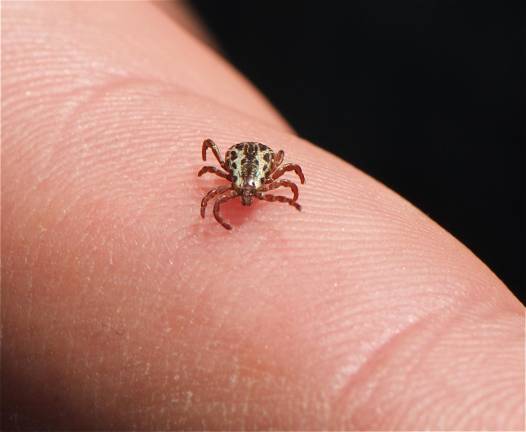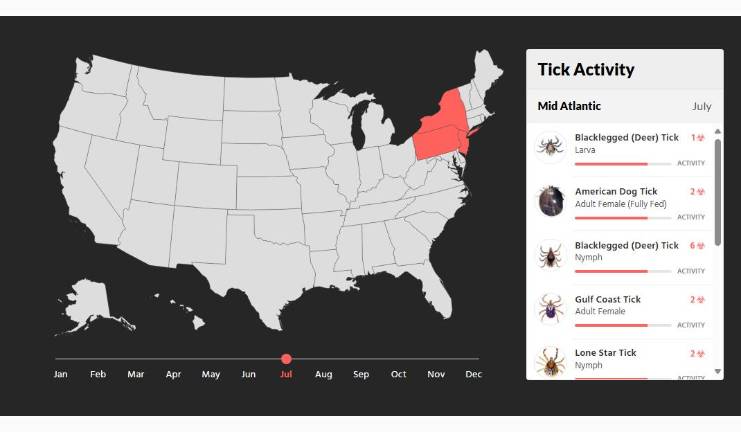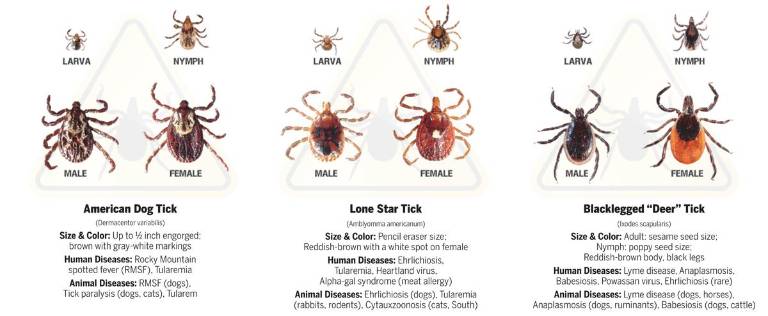Tick-borne illnesses: How to protect people, pets in the height of summer
HEALTH. The number of reported tick-borne illnesses is increasing, not only in quantity but also in variety, health officials say.



Summertime in the Northeast brings many opportunities to be outdoors, but long days spent in backyards, on hiking trails or at parks and campgrounds mean a greater risk of tick bites, and along with that, tick-borne illness.
The Centers for Disease Control (CDC) report a year-over-year rise in emergency room visits for tick bites, and the number of reported tick-borne illnesses is also increasing, not only in quantity but also in variety.
Locally, the biggest health threat from tick bites has historically been contracting Lyme disease from black-legged (deer) ticks, but in recent years, other tick-borne illnesses, such as anaplasmosis, babesiosis and alpha-gal syndrome, have become more prevalent.
While not every tick bite results in disease transmission, recognizing the signs of these illnesses and receiving prompt treatment for them is key for both people and pets. Being tick-savvy can also help prevent bites before they happen, including understanding tick species, habitats and best practices for protection.
Tick populations are booming
Ticks thrive in warm weather conditions, and this summer has been especially hot and humid, contributing to even larger populations. Other factors also contribute to larger tick populations and habitat spread. Deer, a favorite host for black-legged ticks, are also living closer to human and pet populations due to land development and habitat loss.
Changing climate conditions mean that tick populations are migrating, introducing and integrating southern tick species such as the lone star tick into the Mid-Atlantic and New England, which was previously predominantly black-legged tick territory. American dog tick and Asian long-horned tick populations are also growing throughout New York, New Jersey and Pennsylvania.
The increase in ticks is concerning from a public health standpoint, but perhaps more alarming is that larger percentages of those ticks are now carrying disease. A study from Dartmouth University indicates that up to 50 percent of adult and up to 25 percent of juvenile (nymph-stage) black-legged ticks carry Lyme bacteria, and 2024 tick-testing in New York, conducted by the state Department of Health in conjunction with the Upstate Tick Testing Laboratory, indicated that 31 percent of ticks tested carried at least one disease-causing pathogen.
In northern New Jersey, tick-borne illness is following a similar pattern. Sussex County Division of Health epidemiologist Jacqueline Luthcke reports a sharp increase in year-over-year cases.
“Between January and early July 2024, we recorded 416 cases of tickborne illness in Sussex County,” she said, “And in the same time frame for this year (2025), we’ve recorded 591 cases.”
Luthcke said the overwhelming majority, 93 percent in 2024 and 92 percent in 2025, are confirmed cases of Lyme disease, with much of the other percentage being anaplasmosis.
Tick-borne illnesses are so prevalent in Pike County, Pa., that the county maintains a Tick-borne Diseases Task Force, which conducts studies to monitor tick activity and inform the public about illnesses and prevention.
An ounce of prevention
One of the inherent issues with tick populations is their parasitic nature. Because ticks must feed from other live species, tick populations boom where there is more food. That means not only other wild species, but humans and domestic animals. And because the New York-New Jersey-Pennsylvania area is full of the forests, wetlands and edgelands where tick populations flourish, it makes it an ideal disease vector for ticks, wildlife, humans and pets.
That means that whether gardening, doing yard work, hiking, camping, fishing or otherwise enjoying the outdoors, it’s necessary to be vigilant against ticks.
Another inherent issue with ticks is their size. Ticks are very small, some as tiny as a pinhead or a poppy seed, making them difficult to find on people and even harder to find on pets. Preventing tick bites is the first step in avoiding tick-borne illnesses, and preventative measures can be taken for oneself, children, pets and property.
For tick management and tick bite prevention that begins at home, TickTalk.org, a tick information portal maintained by the National Pest Management Association, offers suggestions for keeping ticks out of personal outdoor spaces, including:
When going outdoors for yard work or recreation, tick prevention becomes about awareness and preparation. Because ticks are small and often difficult to see, it’s recommended to wear light-colored clothing and cover exposed skin, such as tucking pants into socks.
CDC recommendations also include using U.S. Environmental Protection Agency (EPA)-registered insect repellants, but only as directed by the product instructions. The EPA maintains a search tool to help people find safe, effective tick repellants for children and adults, including those who are pregnant or breastfeeding. The CDC also has a chat tool called the Insect Repellent “Fight the Bite” Bot to assist in choosing the correct product for their needs.
Once indoors, everyone, including pets, needs to be checked for ticks. Ticks love to catch rides on dog and cat fur and collars, leaving them at risk for bites and humans at risk for transfer concerns.
If ticks are found, they should be removed and washed down a drain or placed in rubbing alcohol.
“Check your pets before coming inside,” Luthcke said, “Brush or comb them if you can, to dislodge any ticks before they bite your pets or before they bring the ticks into your home.”
Luthcke indicated that pet owners should also consider using tick preventatives on their pets, according to their veterinarian’s recommendation. There are also safe usage guidelines available from the American Veterinary Medical Association.
If you find ticks on your clothing, be sure to wash those clothes as soon as possible in hot water to kill any remaining ticks or tick-borne pathogens. Running clothes through a hot dryer is an alternative. People should also shower as soon as possible, during which they should do another thorough tick check; showering may also dislodge any other hidden ticks and prevent tick-borne illnesses - the shorter the time a tick is attached, the less the risk of infection being passed into the bloodstream.
“Showering within two hours of being outdoors can reduce your exposure time, which can reduce your risk of illness,” Luthcke said.
Taking action after a tick bite
If you or your pet has been bitten by a tick, it’s important to remove the tick as soon as possible and monitor for health concerns. Tick-borne illnesses each have an incubation period, and if you or your pet begin to exhibit symptoms of illness, such as the bullseye rash that often accompanies Lyme disease, aching, fever, fatigue or other flu-like symptoms, it’s time to check with a doctor or veterinarian.
“For your pets, we tell people to watch for lethargy and other signs that they’re not feeling themselves,” Luthcke said. “And for people, we tell them to listen to their symptoms. People know what their baseline health is, and when you know you’ve had a tick bite and you’re starting to feel off, it’s important to get to a physician and seek treatment.”
For information about ticks, tickborne illness, and tick safety, go online to cdc.gov/ticks or contact your county’s health department for local data and resources.
